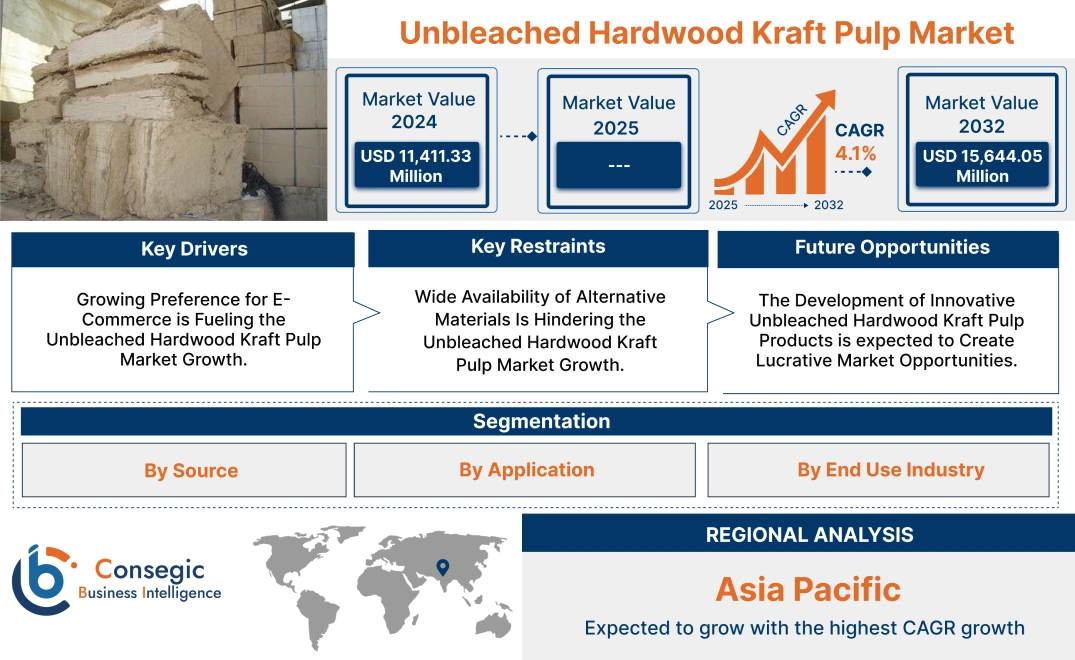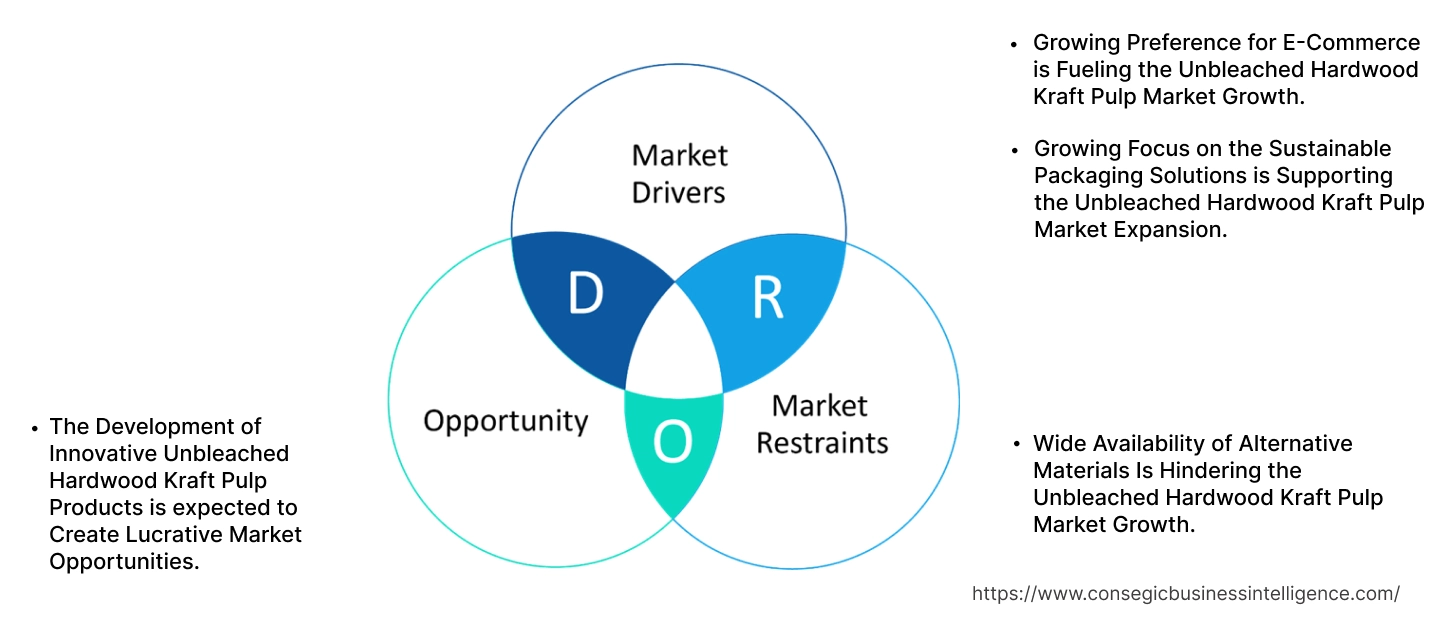- Summary
- Table Of Content
- Methodology
Unbleached Hardwood Kraft Pulp Market Size:
Unbleached Hardwood Kraft Pulp Market size is growing with a CAGR of 4.1% during the forecast period (2025-2032), and the market is projected to be valued at USD 15,644.05 Million by 2032 from USD 11,411.33 Million in 2024.
Unbleached Hardwood Kraft Pulp Market Scope & Overview:
Unbleached hardwood kraft pulp is a type of wood pulp produced from hardwood trees such as eucalyptus, birch, and maple. It is made from hardwood treated with ligninolytic fungi to reduce the need for bleaching chemicals. Unbleached kraft pulp retains its natural brown colour and is known for its high strength. It is a partially delignified pulp that's suitable for various applications including paperboard, corrugated board, tissues, kraft papers, specialty papers, and other products. The requirement for this type of pulp is driven by factors such as the increasing consumerism and the rise of e-commerce, which all contribute to a higher requirement for packaging materials.
Key Drivers:
Growing Preference for E-Commerce is Fueling the Unbleached Hardwood Kraft Pulp Market Growth.
E-commerce relies heavily on shipping products through online mode. This presents a requirement for large volume of boxes, and other packaging materials. Unbleached hardwood kraft pulp serves as a key raw material for producing various packaging materials, such as corrugated boxes, paper bags, and protective cushioning. The surge in e-commerce results into a higher requirement for this kraft pulp.
- For instance, according to the data provided by ECDB, data hub for comprehensive eCommerce analysis, the UK food and grocery eCommerce market is accounts for roughly 13.1% of the total eCommerce market in the United Kingdom.
Henceforth, the rise of e-commerce is a major factor fuelling the demand for unbleached hardwood kraft pulp.
Growing Focus on the Sustainable Packaging Solutions is Supporting the Unbleached Hardwood Kraft Pulp Market Expansion.
Consumers and businesses are increasingly prioritizing environmental health. This results in a requirement for sustainable and eco-friendly packaging solutions. Unbleached kraft pulp is a biodegradable material. It is derived from renewable wood sources. This characteristic makes this kraft paper a more environmentally friendly alternative to traditional packaging material. Companies are actively seeking ways to reduce their environmental footprint. Furthermore, there is a growing preference for sustainable packaging solutions by the consumers.
- For instance, According to the consumer survey results published by Huhtamaki, regarding materials for food and beverages, 67% wanted to see paper-based or cardboard-based materials being used in packaging.
Hence, as per market analysis, the requirement for sustainable packaging is supporting the market.
Key Restraints:
Wide Availability of Alternative Materials Is Hindering the Unbleached Hardwood Kraft Pulp Market Growth.
The market faces significant competition from a wide array of alternative materials. Plastic materials offer benefits such as high strength and durability. Additionally, biodegradable plastics such as polylactic acid (PLA), and polybutylene succinate (PBS) among others present, a renewable alternative. Recycled paper offers environmentally friendly substitute.
Alternative fibres such as bamboo presents sustainable alternative. Bleached hardwood and softwood kraft pulp present high brightness and strength compared to unbleached kraft pulp. These materials provide a range of options for unbleached hardwood kraft pulp. In addition to this, their availability puts pressure on its pricing of unbleached hardwood kraft pulp and limits its market.
Future Opportunities :
The Development of Innovative Unbleached Hardwood Kraft Pulp Products is expected to Create Lucrative Market Opportunities.
The development of high-strength grades of unbleached hardwood kraft pulp supports demanding applications such as heavy-duty packaging. Additionally, the introduction of water-resistant grades through treatments to expands usage of this type of kraft pulp. It creates the adoption of water-resistant kraft pulp products in moisture-sensitive areas including food packaging and outdoor applications. As a result, companies are increasingly focusing on the development of water-repellent unbleached hardwood kraft pulp products.
- For instance, in October 2024, Lintec announced launch of an unbleached and water-repellent kraft paper that resist the permeation of rainwater. It is highly suitable for processing into carrier bags and envelopes.
Thus, as per analysis, innovation in product development creates the unbleached hardwood kraft pulp market opportunities by differentiating products from competitors.
Unbleached Hardwood Kraft Pulp Market Segmental Analysis :
By Source:
Based on source, the market is categorized into birch, maple, eucalyptus, and others.
Trends in the Source:
- Increasing focus on sustainable forestry practice is a trend supporting sustainably sourced eucalyptus pulp.
The eucalyptus segment accounted for the largest unbleached hardwood kraft pulp market share in 2024.
- Eucalyptus is the most widely planted hardwood species globally. This makes it the dominant source for unbleached hardwood Kraft pulp.
- These trees present high growth rates which enable high yields and short rotation cycles for hardwood production. This results in cost-effective and efficient production of unbleached kraft pulp.
- Additionally, eucalyptus is adaptable to a range of soil conditions and climates. As a result, companies are increasingly opting for the adoption of eucalyptus as hardwood for the production of kraft pulp.
- For instance, in August 2024, ANDRITZ launched world’s largest single-line eucalyptus pulp mill for Suzano in Brazil.
- Henceforth, eucalyptus, along with its adaptability, dominates unbleached hardwood kraft pulp market.
The birch segment is expected to grow at the fastest CAGR over the forecast period.
- Birch wood is widely employed for the production of high-quality Kraft pulp. It supports the production of kraft pulp with high strength, smoothness, and stiffness.
- Kraft pulp produced using this hardwood presents high brightness vital for producing high-quality printing and writing papers.
- It also offers high burst strength, tensile strength, and tear resistance, which makes it suitable for applications which are highly demanding.
- It finds several applications in the production of high-quality printing and writing papers, contributing to the overall quality and performance of various paper products.
- Aforementioned factors make birch a fastest growing segment in the overall unbleached hardwood kraft pulp market.
By Application:
Based on applications, the market is categorized packaging materials, tissues and towels, specialty papers, and others.
Trends in Application:
- The increasing focus on the adoption of online distribution channels across several sectors is a trend supporting segment.
The packaging materials segment accounted for the largest market share of 58.8% in the year 2024 and is also expected to grow at the fastest CAGR over the forecast period.
- Unbleached hardwood kraft pulp is extensively employed for the packaging materials such as paperboard, corrugated paper, liners, and wrapping papers among others.
- In corrugated boxes forms kraft pulp forms the core and liner layers and provides durability & strength.
- Growing consumer and regulatory needs for sustainable packaging solutions is boosting the adoption of paper-based alternatives. Unbleached Kraft pulp is biodegradable as well as renewable that aligns with this requirement.
- Additionally, the growing preference for online shopping has fueled a rise in requirement for packaging materials for e-commerce shipments. This further supports the segment trajectory.
- For instance, according to the data provided by the International Trade Administration in May 2024, Singaporean eCommerce market’s gross merchandise volume shows an growth rate of 10.28% by 2025. Total number of online shoppers accounted for 3.51 million in Singapore.
- As a result, the e-commerce surge is a prominent factor for the market, particularly within the packaging materials segment.
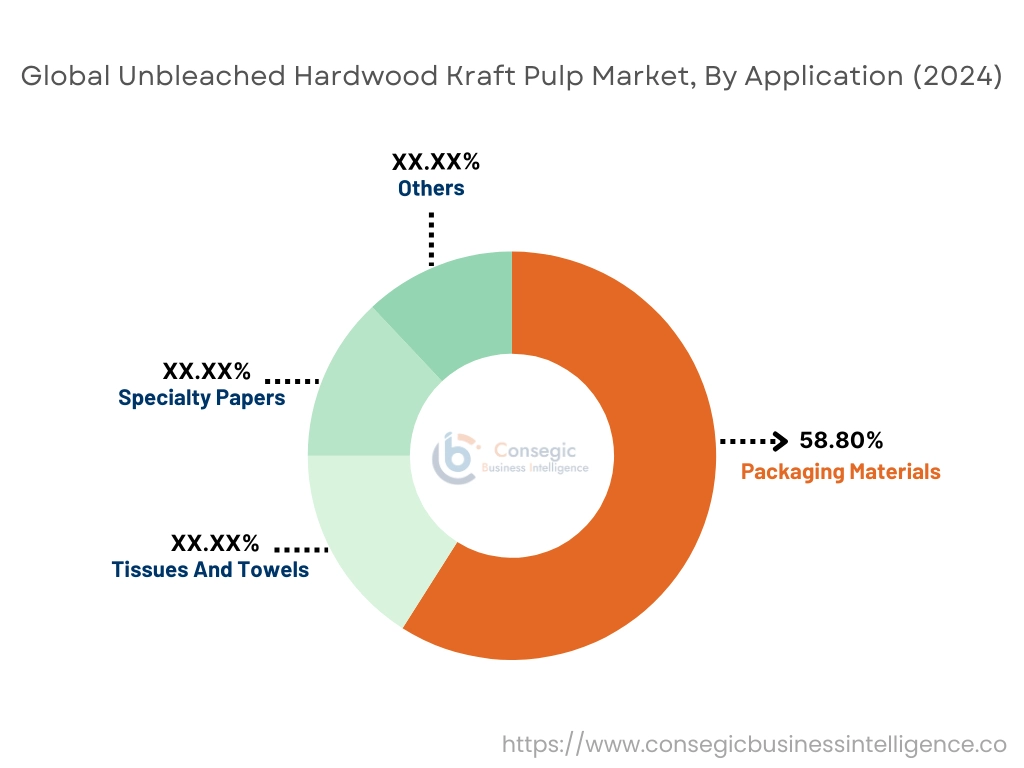
By End Use Industry:
Based on end use industry, the market is categorized into printing and publishing, food and beverage, consumer goods, hospitality, personal care, and others.
Trends in the End Use Industry:
- Increasing focus on innovative packaging solutions such as flexible packaging is a factor positively impacting the unbleached hardwood kraft pulp market analysis.
The food and beverage segment accounted for the largest market share in the year 2024.
- The food and beverage sector represents a large unbleached hardwood kraft pulp market share, owing to its extensive use in packaging applications.
- In the food and beverage sector this type of kraft pulp is widely utilized for corrugated boxes, paper bags, food trays, paper cups, and various other packaging formats.
- A number of factors support the growth of this segment. The increasing emphasis on sustainability is driving a shift towards eco-friendly packaging solutions.
- Furthermore, the increasing consumer preference for convenient and on-the-go food options, such as ready-to-eat meals and snacks, is contributing to a higher requirement for suitable and easily disposable packaging.
- For instance, according to data provided by Egg Soldiers, a hospitality professionals group, UK consumers are gravitating towards convenient and ready-to-eat puddings with revealing in March that sales of arctic rolls were up 143% compared to the 2022.
- As a result, growth in online grocery shopping coupled with the rising need for convenient food options is supporting the segment expansion in unbleached hardwood kraft pulp market demand.
The hospitality segment is expected to grow at the fastest CAGR over the forecast period.
- The hospitality sector offers a growing market for unbleached hardwood kraft pulp.
- This type of kraft pulp finds applications in this sector include disposable tableware such as plates, cups, and cutlery. It is also utilized in products commonly found in hotels, restaurants, and other hospitality establishments, such as napkins and tissues.
- The hospitality sector is moving towards more sustainable practices, favoring eco-friendly and biodegradable options like unbleached kraft pulp.
- The global tourism sector is continuously expanding. This results in rising demand for hospitality services leading to a higher demand for this kraft pulp in several applications.
Regional Analysis:
The regional segment includes North America, Europe, Asia Pacific, the Middle East and Africa, and Latin America.
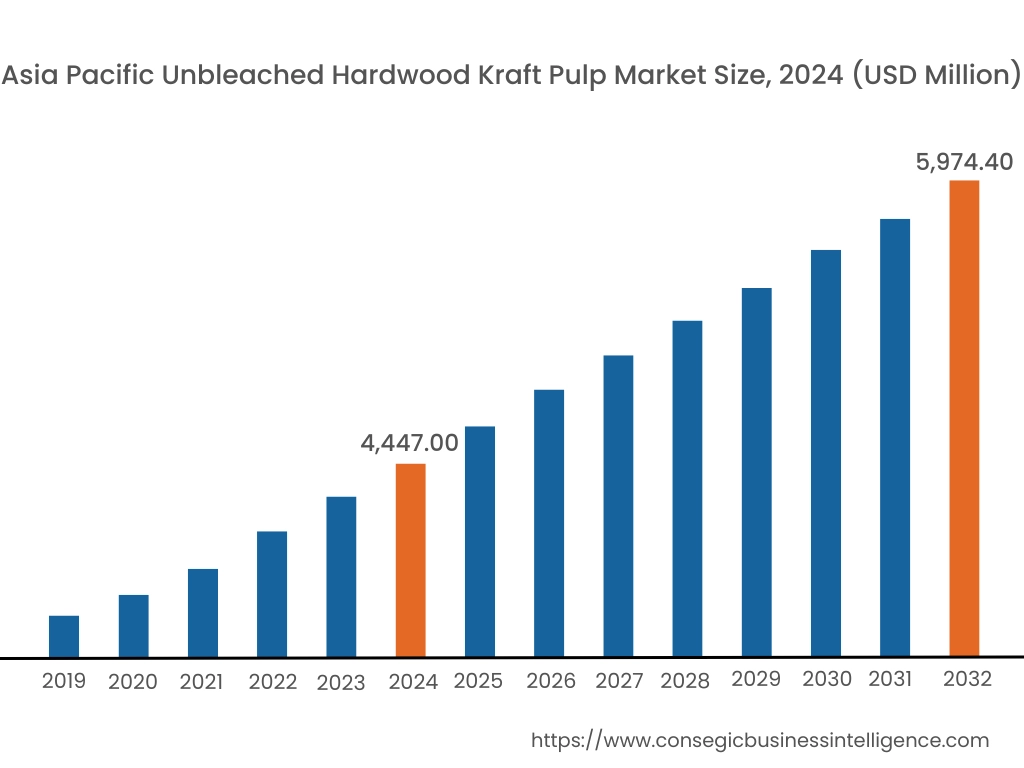
In 2024, Asia Pacific accounted for the highest market share at 28.97% and was valued at USD 4,447.00 Million and is expected to reach USD 5,974.40 Million in 2032. In Asia Pacific, China accounted for the highest market share of 32.41% during the base year of 2024.
Asia Pacific dominates the global unbleached hardwood kraft pulp market, primarily due to the rapidly accelerating adoption of packaging materials. Strong economic growth and rapid industrialization across the region is driving the requirement for industrial packaging, such as corrugated boxes and other shipping materials. This includes adoption of unbleached hardwood kraft pulp for packaging across various sector such as food and beverage, consumer goods, and others.
- For instance, according to the India Brand Equity Foundation India continues to lead the global paper market, with domestic consumption of packaging paper and paperboard growing at 8.2% from 2023-24.
Additionally, rising disposable incomes and changing lifestyles are fueling demand for consumer goods, which in turn drives the requirement for packaging materials. The combination of the aforementioned factors is driving a substantial trajectory in the Asia Pacific market.
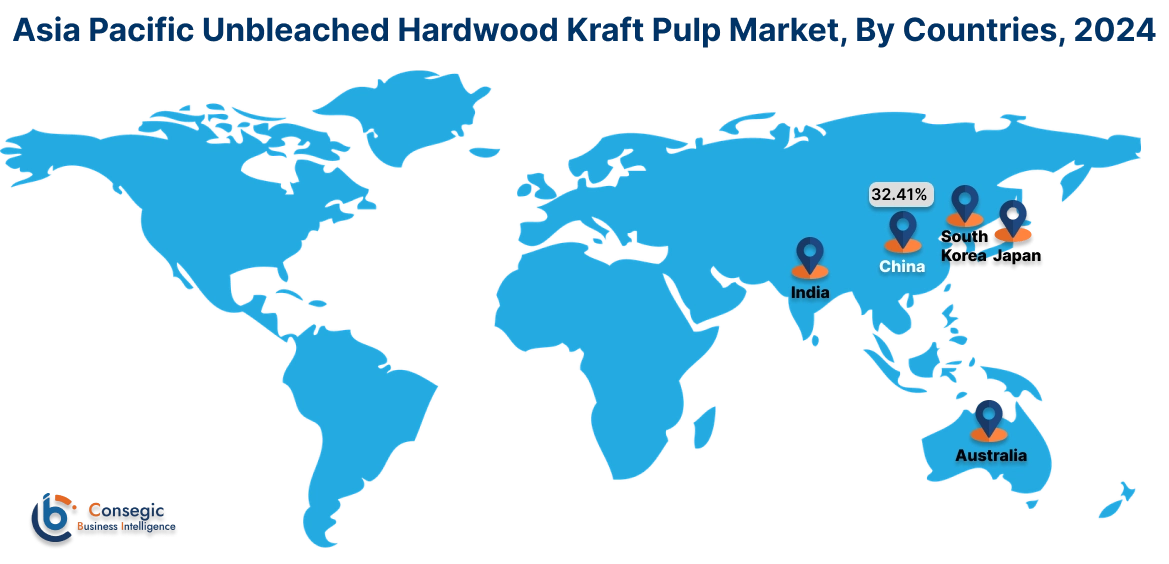
North America is experiencing the fastest growth with a CAGR of 4.8% over the forecast period. The unbleached hardwood kraft pulp market trend across the region is attributed primarily to the expanding e-commerce sector across the region. The well-developed e-commerce sector across the region creates large requirement for unbleached hardwood pulp for packaging materials. A stable economy and growing consumer confidence have fueled spending across various sectors, including e-commerce. Additionally, the well-established food & beverage and healthcare sector of North America supports the unbleached hardwood kraft pulp market expansion.
Europe presents a significant contribution to the unbleached hardwood kraft pulp market analysis. The European food and beverage sector is mature, creating constant requirements for packaging solutions. Additionally, factors including stringent environmental regulations, increasing focus on sustainability, and the rising preference for eco-friendly packaging, are supporting the unbleached hardwood kraft pulp market opportunities across the region. European consumers are increasingly environmentally conscious, driving requirements for sustainable products. Industries are responding by incorporating sustainable practices into their packaging solutions.
The Middle East and Africa (MEA) region is witnessing a notable market characterized by significant potential. The MEA regions are experiencing rapid industrialization and urbanization, driving significant rise in the food and beverage sector. The food and beverage sector in the Middle East and Africa is expanding, with an increasing requirement for packaging solutions. Additionally, the personal care sector in the Middle East refers to a rapidly growing market where consumers spend significantly on beauty products including skincare. This trend is creating unbeached hardwood kraft pulp market opportunities in the MEA.
Latin America is an emerging region in the unbleached hardwood kraft pulp market trend, with significant potential for innovation. The region boasts abundant forest resources, providing a basis for the pulp and paper sector. Brazil serves as one of the top hardwood producing countries across the region. This creates high availability of wood chips for the production of kraft pulp. This analysis presents a substantial opportunity for manufacturers and suppliers to capitalize on this burgeoning market and contribute to the region's unbleached hardwood kraft Pulp market requirement.
Top Key Players and Market Share Insights:
The Unbleached Hardwood Kraft Pulp market is highly competitive with major players providing precise products to the national and international markets. Key players are adopting several strategies in research and development (R&D) and product innovation to hold a strong position in the global Unbleached Hardwood Kraft Pulp market. Key players in the Unbleached Hardwood Kraft Pulp industry include-
- Stora Enso (Finland)
- Canfor (Canada)
- Georgia-Pacific LLC (U.S.)
- UPM (Finland)
- WestRock Company (U.S.)
- Mercer International Inc. (Canada)
- ARBROS (Dubai)
- Suzano (Brazil)
Unbleached Hardwood Kraft Pulp Market Report Insights :
| Report Attributes | Report Details |
| Study Timeline | 2019-2032 |
| Market Size in 2032 | USD 15,644.05 Million |
| CAGR (2025-2032) | 4.1% |
| By Source |
|
| By Application |
|
| By End Use Industry |
|
| By Region |
|
| Key Players |
|
| North America | U.S. Canada Mexico |
| Europe | U.K. Germany France Spain Italy Russia Benelux Rest of Europe |
| APAC | China South Korea Japan India Australia ASEAN Rest of Asia-Pacific |
| Middle East and Africa | GCC Turkey South Africa Rest of MEA |
| LATAM | Brazil Argentina Chile Rest of LATAM |
| Report Coverage |
|
Key Questions Answered in the Report
How big is the Unbleached Hardwood Kraft Pulp market? +
In 2024, the Unbleached Hardwood Kraft Pulp market is USD 11,411.33 Million.
Which is the fastest-growing region in the Unbleached Hardwood Kraft Pulp market? +
North America is the fastest-growing region in the Unbleached Hardwood Kraft Pulp market.
What specific segmentation details are covered in the Unbleached Hardwood Kraft Pulp market? +
Source, Application, and End Use Industry segmentation details are covered in the Unbleached Hardwood Kraft Pulp market.
Who are the major players in the Unbleached Hardwood Kraft Pulp market? +
Stora Enso (Finland), WestRock Company (U.S.), and Mercer International Inc. (Canada) are some of the major players in the market.
